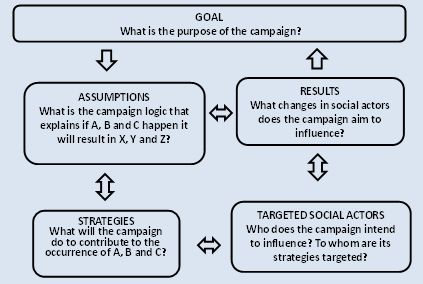The theory of change describes how the change that a campaign promotes can happen: what do the target audiences need to do to bring about the desired change? What are the assumptions that guide the campaign to the long-term goals it seeks to achieve? An explicit theory of change helps to determine the most effective ways to influence target audiences. Agreeing on a theory of change is a key element in building shared understanding within a campaign team or an alliance. It brings together goals, strategies and outcomes in a coherent story, providing language across divergent interests, constituencies and styles of working within a team or an alliance (Klugman, B., 2009. Less is More– Thoughts on Evaluating Social Justice Advocacy).
The theory of change should be grounded in robust, relevant findings from research. Behaviour change campaigns increasingly draw on established scientific theories on human behaviour change, some of which are outlined in Campaign Approaches in this module. The theory of change should be described in a few simple sentences or visualized on a chart (see below for examples), and discussed with others, including people who know nothing about the campaign, to identify aspects that need further thought and more clarity.
The Theory of Change as a Strategic Plan for a Campaign
The transformation and innovation required to change the power relations that are at the root of gender-based violence require moving in complex environments in which a VAW campaign can only partly predict what will be the results of activities, and therefore cannot present a solid plan laying out the relationships of cause and effect between activities, outputs and outcomes. In addition, although the challenges or problems they face may be clear – and often they are not – there tends to be disagreement about how to address them. And when they achieve a solid solution to a given problem, each situation is so dynamic that only rarely is the solution replicable in other times or contexts.
In these complex situations, the typical methodologies, models, or logical frameworks of results-based management rarely are useful. They assume that you can predict a series of cause/effect relationships in the logical chain inputs activities - outputs - outcomes - impact when those relationships are fundamentally unpredictable. As noted by the United Nations: "An inherent constraint of results-based management is that a formalistic approach to codifying how to achieve outcomes can stifle the innovation and flexibility required to achieve those outcomes.”
Source: UN Office of Internal Oversight Services, UN A/63/268, 22 September 2008. Review of results-based management at the United Nations.
How then to manage a campaign for results? Use a theory of change
A theory of change (ToC) presents a broad view of the desired change, describing "a process of planned social change, from the assumptions that guide its design to the long-term goals it seeks to achieve." It identifies the assumptions, strategies, actors and outcomes that are expected to interact and enhance one another in the campaigning.

See the Grant Craft Guide: Mapping Change (Foundation Center and European Foundation Center, 2006.
Depending on the goals and context of the campaign, its theory of change can be quite simple or highly complex. The two broad types of campaigns to end VAW – advocacy campaigns and campaigns for behaviour change – reflect two general theories of change: advocacy campaigns (generally geared towards institutional and policy change) are based on the idea that more effective rules and mechanisms, such as laws, protocols, policies, infrastructure, etc. in society are needed to end violence against women and girls, while campaigns for behaviour change put the emphasis on individual thoughts, emotions and decisions, as well as social norms and practices, that play a role in ending violence against women and girls. Within these two broad categories, each campaign has its own implicit or explicit theory of change.
It is important to note that the way in which desired policy or institutional change comes about, is not necessarily as straightforward. It is now widely recognized that change takes place within complex, multi-level dynamics that are only partly predictable and may be subject to multi-directional forms of causality (Klugman, 2009. Less is More…). Hence, models used in behaviour change and communications theories, may also be relevant to advocacy campaigns.
Tool:
The Grant Craft Guide: Mapping Change (Foundation Center and European Foundation Center) available in English, provides guidance on using a theory of change in strategic planning. While targeted at grant makers, the 10-page guide can also be a useful tool for anyone involved in campaign planning and monitoring.